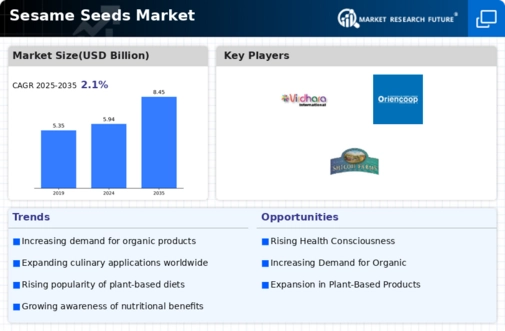Top Industry Leaders in the Sesame Seeds Market

The competitive landscape of the sesame seeds market is marked by robust competition among key players aiming to secure a prominent position in this dynamic industry.
Key players in the sesame seeds market include
- Olam International
- Dipasa Europe B.V.
- Unicorn Ingredients Limited
- Virdhara International
- Tradin Organic Agriculture B.V.
- Samruddhi Organic Farm (India) Private Limited (India)
- Orienco (France)
- Shiloh Farms (Pennsylvania)
- Akay Agro Allied
Various strategies are employed by these industry leaders to sustain and enhance their market presence. One common approach is vertical integration, where companies engage in multiple stages of the sesame seeds supply chain, from cultivation and processing to distribution. Olam International, for instance, has strategically integrated its operations, allowing the company to have better control over product quality and supply chain efficiency.
Strategies Adopted:
Strategic collaborations and partnerships are also prevalent in the sesame seeds market. Companies like SunOpta Inc. engage in partnerships with local farmers and suppliers to ensure a stable and consistent supply of high-quality sesame seeds. Such collaborations contribute to the diversification of sourcing channels and mitigate risks associated with supply chain disruptions.
Product differentiation is another key strategy in this competitive market. Archer Daniels Midland Company focuses on developing and marketing innovative sesame seed products to cater to evolving consumer preferences. Introducing value-added products such as sesame-based snacks or specialty oils allows companies to differentiate themselves in a crowded market.
Market Share Analysis Factors:
Market share analysis in the sesame seeds sector is influenced by various factors. Quality assurance is a crucial factor determining market share, as consumers and food manufacturers alike prioritize sesame seeds with consistent quality and safety standards. Companies investing in stringent quality control measures, such as Selet Hulling Corporation, often gain a competitive edge in the market.
Pricing strategies play a pivotal role in market share dynamics. Offering competitive prices or implementing dynamic pricing strategies can influence purchasing decisions. Sun Agro Seeds Ltd. strategically adjusts its pricing based on market trends and input costs, allowing the company to remain competitive while maximizing profitability.
New & Emerging Companies:
The entry of new and emerging companies adds dynamism to the sesame seeds market. These companies often leverage technological advancements and sustainable practices to establish a foothold. Their entry challenges established players to innovate and adapt to changing market dynamics. As smaller players introduce unique varieties or specialty products, the market becomes more competitive, fostering innovation and meeting niche consumer demands.
Industry Trends:
Industry news and current investment trends provide insights into the evolving dynamics of the sesame seeds market. Companies are increasingly investing in technologies that enhance processing efficiency and sustainability. SunOpta Inc., for example, has invested in modern processing facilities to meet the growing demand for processed sesame seed products. These investments align with the broader industry trend of adopting eco-friendly practices and ensuring supply chain sustainability.
Competitive Scenario:
The overall competitive scenario in the sesame seeds market is shaped by global market trends and regulatory considerations. Compliance with international quality standards and food safety regulations is imperative for companies aiming to maintain a strong competitive position. Key players consistently invest in meeting and exceeding these standards to build consumer trust and safeguard their market positions.
Recent Development
Recent developments in the sesame seeds market indicate a continued emphasis on sustainability and technological advancements. Companies are increasingly adopting precision agriculture techniques to optimize cultivation practices, reduce resource usage, and enhance crop yields. This trend reflects the industry's commitment to environmentally responsible practices and aligns with global efforts to achieve sustainable agriculture.


